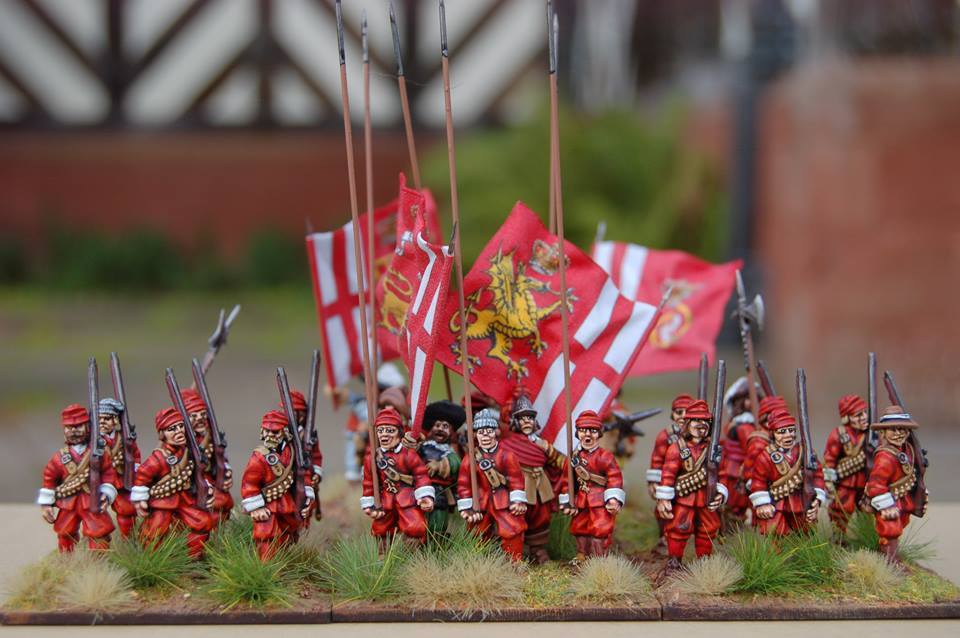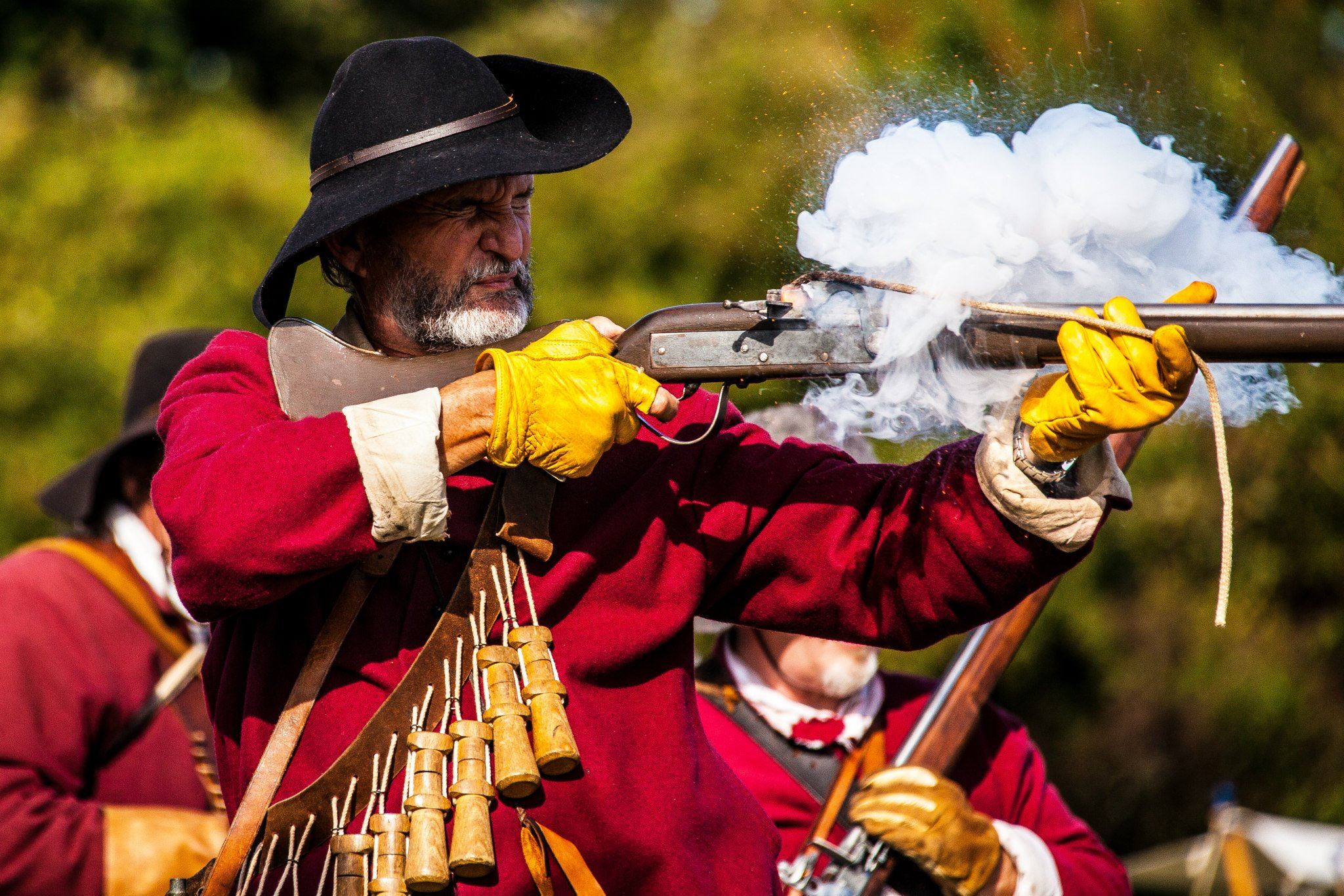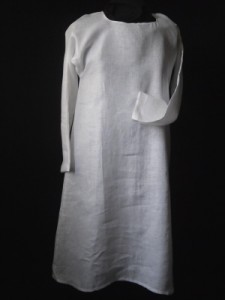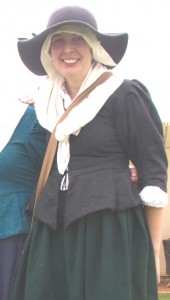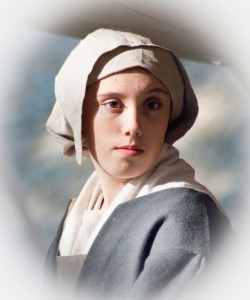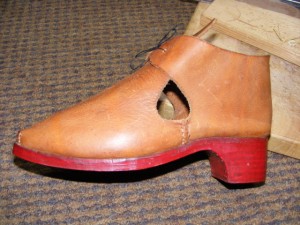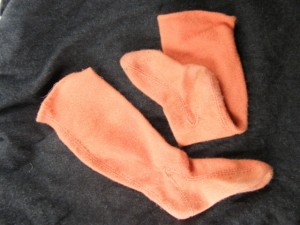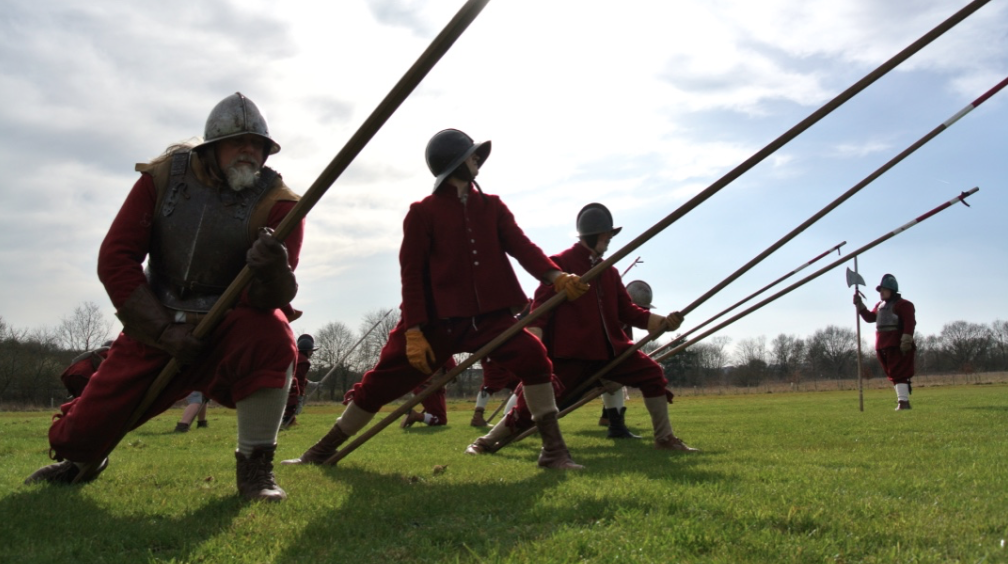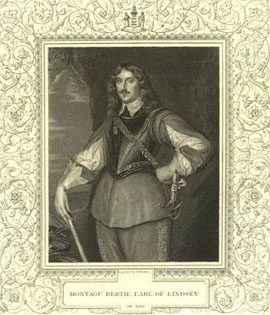What The KG Wore in the Three Kingdoms Wars
What the KG wore in the Three Kingdom’s Wars Dec 2011 (part 1)
Dowloadable Word Document Dec 2011 (part 2)
Introduction
This pictorial guide is intended to show you the easiest way to look good in basic seventeenth century kit. It’s not a comprehensive guide to all the clothes from the 1640s. It can’t be. There is no such thing. There are so few remaining examples of clothes from this period and so little pictorial evidence to show what was worn by the soldiers and those women who chose to follow an army in the England of the 1640s that most conclusions can only be best guesses. However if you use these guidelines you will end up with a basic set of kit that is as far as we can tell accurate in the fashion of the times, method of construction and use of fabric. It will help you to look more like someone who has just stepped out of the past than a person in fancy dress.
In the 1640s, the two fabrics mostly used for common clothes were woven wool, which was felted with a fuzzy nap on the surface and unbleached, natural coloured linen. Both fabrics are, at the time of writing available from suppliers so there should be no excuse for making or buying garments made from anything else. These natural fabrics are practical and hardwearing and will give you clothes that will last for years if you look after them. There were no detergents to wash clothes, and woollen garments were generally not washed at all but brushed occasionally to remove surface dirt. Most clothes would end up with a patina of ingrained dirt from campaigning, though it’s reasonable to assume that linens would be washed on a regular basis. Just make sure you don’t end up with the modern “whiter than white, neatly pressed” look.
The range of colours available was quite broad, but the less well off (actually the best part of a seventeenth century army was less than affluent) made use of very few of them. Their clothes were also often so old and reused that they had faded to dull grey or brown or had been re-dyed several times.
For the King’s Oxford Army of which we are a part, there is reference to a kit issue for the soldiers.
In a diary written by the Oxford schoolboy during the war, this entry for 15th July 1643 records exactly what was issued:
“And upon the next, viz Saturday all the common soldiers then at Oxford were new apparelled, some all in red, coats, breeches, and monteroes, and some all in blue” (The Life and Times of Anthony Wood)
And this in a letter from the Earl of Bath dated 11th July:
“Your servant Tom Bold is now in a company of the Life Guards in a red suit and montero which they wear” (Strangers in Oxford p44)
We think that the red they chose came from the Stroud mills, probably captured after the fall of Cirencester. The colour would probably have been quite a deep shade but would fade in patches where it was exposed to the sun. A tricky thing to copy using modern fabrics, but look for a dense felted (fuzzy) wool in a deep, but not too dark red. Ask advice from your company goodwife if you are unsure.
The following colours are suitable for more general purpose: grey, brown terracotta/brick/russet reds, grey-blue or dark dull blues, dull shades of green, mustard yellow/ochre, heathery shades of purple, cream/undyed (remember it will get dirty and never come fully clean).
Details and accessories are important to create the overall look. Make sure any buttons 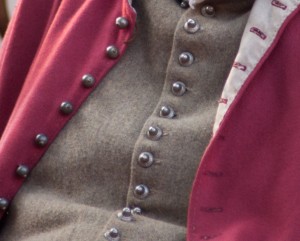 conform to the 1640s style, small, round ball shaped buttons with a single shank or stalk to attach to the garment were worn, either metal, cloth or wooden beads wrapped with thread. Don’t choose wide belts with massive buckles. Seventeenth century belts were no wider than 3cm perhaps and the buckles were of a matching size. Belts were worn over the coat/doublet to hold a bag. Though practicality would suggest it to modern eyes, they were not to keep your breeches up.
conform to the 1640s style, small, round ball shaped buttons with a single shank or stalk to attach to the garment were worn, either metal, cloth or wooden beads wrapped with thread. Don’t choose wide belts with massive buckles. Seventeenth century belts were no wider than 3cm perhaps and the buckles were of a matching size. Belts were worn over the coat/doublet to hold a bag. Though practicality would suggest it to modern eyes, they were not to keep your breeches up.
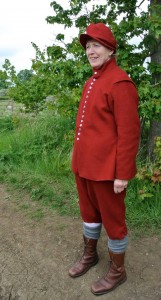 Try and feel comfortable in your chosen clothes and act like a seventeenth century person would, always wear your hat, keep the top buttons fastened, don’t go out in your shift. Wearing just a shirt was just acceptable for a labourer working in the sun, but probably little else! Be proud of your clothes, they will provide you with protection and warmth. Don’t leave them to go ragged, patch them up when they tear, keep the linen clean and the wool brushed when it gets muddy.
Try and feel comfortable in your chosen clothes and act like a seventeenth century person would, always wear your hat, keep the top buttons fastened, don’t go out in your shift. Wearing just a shirt was just acceptable for a labourer working in the sun, but probably little else! Be proud of your clothes, they will provide you with protection and warmth. Don’t leave them to go ragged, patch them up when they tear, keep the linen clean and the wool brushed when it gets muddy.
If you are in doubt on any of these points, ask your company commander or the goodwife for advice. It’s better to ask than buy the wrong kit and waste your money on something that is wrong. Patterns are also available for most of the clothes described here if you’d like to make your own things.
There is more information and further links on all sorts of 1640s style clothes and kit on the blog found here:
http://thegoodwyfe.blogspot.com
Part One: Women
The universal undergarment is the SHIFT or SMOCK, a long-sleeved T-shaped garment of unbleached linen reaching to mid-calf. It is either cut loosely or has triangles known as gores added at the sides. Contemporary Dutch pictures show poorer women with high necklines, sometimes left unfastened whilst working. We can probably assume this fashion was popular here too. Tapes, attached to the neckband, were used to fasten the neckline whilst tapes, small buttons or thread toggles can be used to fasten cuffs. There is no evidence for drawstrings around the neck in this period. Any gathering would have been permanent and sewn to a neckband. Smocks were also used as nightgowns
Over the smock you wear a SKIRT or PETTICOAT, made of wool or linen. If your cloth is thick, full and heavy enough, you can wear a single skirt, though often more than one was worn, especially in winter. The length should be about a hand’s breadth above your ankle. Most common women wore relatively short skirts to keep hemlines well out of the muck. Longer lengths were worn only by the higher classes
The fabric of the skirt should be gathered with cartridge pleats into a waistband. This will provide more than enough fullness for a seventeenth century shape as long as the wool used is thick enough. The skirt can be fastened either by a plain round metal or cloth shanked button, a large hook-and-eye or laces (through lace-holes or fixed at either end of the waistband). The bottom edge should really be hemmed for most roles ragged edges indicate abject poverty. Small simple braids or ribbons can be used to reinforce the edges. Ask advice on this one.
A second skirt (if you want one) is made identically to the first, though make sure that the top skirt is of reasonably thick or coarse wool or linen. If you want to lift or tuck this up, you must wear another skirt underneath to avoid displaying your smock (that would be like going out with your skirt tucked into your knickers).
Over the shift you wear STAYS, sometimes called a CORSET. Your costume will not fit properly without them, unless your bodice is fully boned. Contemporary Dutch pictures show women doing strenuous manual work in stays, having discarded their bodice: a good option for hot weather! The outer fabric can be plain/dyed linen or wool. A layer of stiff canvas as an inner lining with boning all round provides stiffening. Patterns are quite simple and can be obtained from various sources.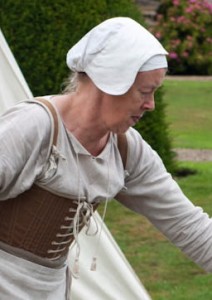
Back-laced styles can be tricky to lace up by your self and would probably only be worn by someone who could afford a servant to help. Front-laced styles are easier to manage. Shoulder straps can be either integral to the stays or separate pieces/tapes laced in when worn. Stays are not meant to be uncomfortable they should just provide the outline, not constrict your breathing. Tabs at the back and side are tucked under skirt to take weight off your lower back and spread it through the boning.
Over stays, a BODICE is worn. If you prefer, you can wear a boned bodice instead of separate stays. Both are made of wool, or linen and lined. The main thing is to make sure you have enough foundation to give you the 1640s silhouette. A simple bodice may have a high or medium neckline, with full or close-fitting sleeves and split tabs or inserted triangular gores below the waistline. It can be fastened with tapes or laces, buttons were a man thing as far as we can tell. If you wear a bodice over stays, you only need to bone the front edges to prevent puckering when you lace it up. Otherwise full boning needs to be sewn into the lining of the bodice.
JACKETS are more old-fashioned, but common in contemporary paintings of lower class women from the 1640s. They are tied up the front by, ribbons, laces or hooks-and-eyes. Sleeves can be full or close fitting as for bodices. Jackets may have been collarless and the front edges can be boned or stiffened with a double thickness of heavy canvas strips sewn into the lining.
You cannot go into or through public areas or the battlefield with only a smock covering your upper body (this is the 17th Century equivalent of going out wearing only your bra), so you must wear at least a bodice or jacket.
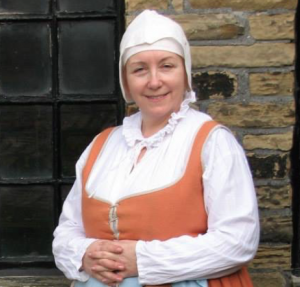 The most important accessory is the COIF, CAP or BONNET. This is made of unbleached linen and can be worn on its own or under a wide brimmed HAT. There are several styles shown in contemporary pictures, but the most common, certainly the best represented in museum collections comes in two parts. The CROSSCLOTH was tied on first, to a bun of hair gathered behind and the COIF was then pinned onto the cloth. Hair is hidden almost completely, although with coifs, part of the hair can sometimes be seen, combed back off the forehead. Serving women are shown, in contemporary pictures, apparently wearing a length of cloth wrapped turban-style around their heads, instead of a bonnet. Hats were often of felt or leather, sometimes fashionably high-crowned or else fairly shapeless.
The most important accessory is the COIF, CAP or BONNET. This is made of unbleached linen and can be worn on its own or under a wide brimmed HAT. There are several styles shown in contemporary pictures, but the most common, certainly the best represented in museum collections comes in two parts. The CROSSCLOTH was tied on first, to a bun of hair gathered behind and the COIF was then pinned onto the cloth. Hair is hidden almost completely, although with coifs, part of the hair can sometimes be seen, combed back off the forehead. Serving women are shown, in contemporary pictures, apparently wearing a length of cloth wrapped turban-style around their heads, instead of a bonnet. Hats were often of felt or leather, sometimes fashionably high-crowned or else fairly shapeless.
A KERCHIEF is worn around neck and shoulders. In its simplest form, it is a square of unbleached linen or hemp folded diagonally, with the underside slightly longer and fastened with brass pins at the front. The ends are shown sometimes tucked into bodice fronts in paintings. It protects the back of your neck from sunburn and, on cold days, keeps your chest warm.
An APRON should be worn for general work. This consists of a simple rectangle tied  around the waist. Posh ones can be decorated with braid or ribbon, but for the majority of living history tasks, plain linen or wool is fine.
around the waist. Posh ones can be decorated with braid or ribbon, but for the majority of living history tasks, plain linen or wool is fine.
KNITTED WOOLLEN SHAWLS or CLOAKS can be worn in cold or wet weather. Cloaks are probably less common than shawls among the poorest people, and some travellers may have worn leather ones. The simplest cloak is a semicircle of woollen cloth, worn around the shoulders with no fixing.
17th Century SHOES are commonly known as latchet shoes. Reproductions are available from several traders Try and buy the best you can afford. You won’t regret it. They will be more comfortable and last for years. Some companies may have a small stock for new members, so you may have time to save up for your own. Low-heeled men’s styles are suitable for the poorest women, though generally women’s shoes were different to the men’s styles. For a lady’s shoe, with higher heels and narrower foot, prices are higher and they are usually made-to-measure.
The remaining bits of the costume are more or less out of sight. You can buy or knit your own woollen HOSE. These ones are sewn from authentic wool fabric. An acceptable modern substitute is plain woollen tights or unribbed knitted stockings in any of the colours mentioned earlier. Shaped linen or cloth hose are also worn. Hose should be held up by cloth GARTERS or strips of cloth.
To summarise, you need a SHIFT, one or two SKIRTS, STAYS, BODICE or JACKET, COIF, BONNET, KERCHIEF, HOSE and SHOES for your basic costume. If you must carry things make a leather bag can be hung from a belt around your waist or you may carry a basket. POCKETS for women at this time are still ‘little bags’ and (we think) carried under a petticoat on a linen tape around the waist.
Thanks to Alan Mackinnon & Rusty Aldwinckle for some of the photos. The others were ripped off Facebook. I hope you don’t mind!
Gillian Thomson and Ian Dicker December 2011
What the KG wore in the Three Kingdoms Wars Part 2
Men
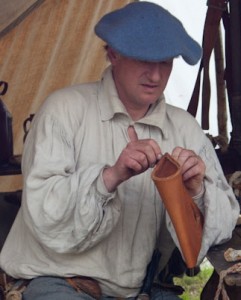 The basic undergarment for all men is the SHIRT. It is a T-shaped, knee length garment made of unbleached linen, with a lot of fabric in the body and sleeves, gathered into cuffs for the sleeves and into a neckband for the body. Large square pieces of fabric are inserted under the sleeves to form gussets White cloth was the prerogative of richer men and dyed fabric far too expensive to waste on shirts. A soldier’s shirt can be of a coarser weave than an officer’s, but they are all basically the same shape. A shirt is cut high to the neck with an upstanding neckband about 2-3cm high and the neck opening should be long enough for the shirt to go over your head and is tied at the top with a single tie or bandstring.
The basic undergarment for all men is the SHIRT. It is a T-shaped, knee length garment made of unbleached linen, with a lot of fabric in the body and sleeves, gathered into cuffs for the sleeves and into a neckband for the body. Large square pieces of fabric are inserted under the sleeves to form gussets White cloth was the prerogative of richer men and dyed fabric far too expensive to waste on shirts. A soldier’s shirt can be of a coarser weave than an officer’s, but they are all basically the same shape. A shirt is cut high to the neck with an upstanding neckband about 2-3cm high and the neck opening should be long enough for the shirt to go over your head and is tied at the top with a single tie or bandstring.
A COLLAR or FALLING BAND is worn with shirts, not part of the shirt, but a separate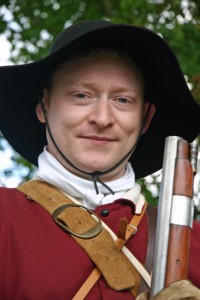 item. In this period it is a rectangle of linen, long enough to go around the neck of the wearer and varies from a hands width to about 20cm deep. The top long edge is gathered into sewn darts, matching the length to your neck measurement and shaping the band. A second rectangle forms the NECKBAND. One edge is turned over and sewn to the underside of the collar’s top edge. Bandstrings are sewn to the ends. The collar’s band sits inside the shirt’s neckband; the collar itself lies outside any jacket. Both shirt and collar are fastened with ties or laces. For common soldiers a tied length of linen tucked into the coat’s standing collar can also be worn
item. In this period it is a rectangle of linen, long enough to go around the neck of the wearer and varies from a hands width to about 20cm deep. The top long edge is gathered into sewn darts, matching the length to your neck measurement and shaping the band. A second rectangle forms the NECKBAND. One edge is turned over and sewn to the underside of the collar’s top edge. Bandstrings are sewn to the ends. The collar’s band sits inside the shirt’s neckband; the collar itself lies outside any jacket. Both shirt and collar are fastened with ties or laces. For common soldiers a tied length of linen tucked into the coat’s standing collar can also be worn
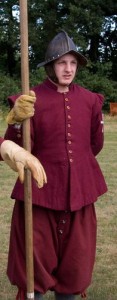 Over the shirt a DOUBLET, or SOLDIER’S COAT is worn. The coats were made for regiments to common patterns in quantity, so their fit was not exact. As explained in the introduction, the King’s Guard were issued with red coats, of woollen cloth so this is what we should be portraying. The simplest style is a loose-fitting garment with body and tabs cut in one piece and with seams sewn only from neck to lower rib-height. Overall length of doublets, etc. is to the hip, not the thighs like jackets worn today. The upper body section may end above the modern waistline.
Over the shirt a DOUBLET, or SOLDIER’S COAT is worn. The coats were made for regiments to common patterns in quantity, so their fit was not exact. As explained in the introduction, the King’s Guard were issued with red coats, of woollen cloth so this is what we should be portraying. The simplest style is a loose-fitting garment with body and tabs cut in one piece and with seams sewn only from neck to lower rib-height. Overall length of doublets, etc. is to the hip, not the thighs like jackets worn today. The upper body section may end above the modern waistline.
Soldier’s coats were lined or unlined, depending on how much money a Colonel was prepared to spend, but doublets were generally higher quality items and would be lined and tailored to fit and time was taken to finish them properly. Sleeves are close fitting, sometimes with turned-back cuffs and wings over the sleeve tops. Collars are high, stiffened with layers of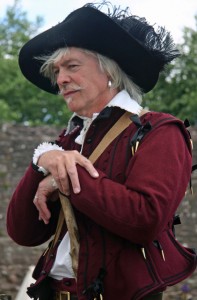 canvas or pasteboard. For high-waisted styles, you need matching breeches that are longer in the crotch. Coats are fastened down the front with several closely spaced buttons, a dozen at least on a soldier’s coat, more for a doublet. They should be shaped like a ball and shanked but can be made of cloth, pewter or wooden beads wrapped with thread. Cloth buttons are more comfortable on a soldier’s coat if you are going to wear armour over the top.
canvas or pasteboard. For high-waisted styles, you need matching breeches that are longer in the crotch. Coats are fastened down the front with several closely spaced buttons, a dozen at least on a soldier’s coat, more for a doublet. They should be shaped like a ball and shanked but can be made of cloth, pewter or wooden beads wrapped with thread. Cloth buttons are more comfortable on a soldier’s coat if you are going to wear armour over the top.
BREECHES are made from wool cloth, normally using a limited colour range, what were known as sadd colours: brown, grey, dull green etc., although we KG were issued with breeches to match the coats. Style depended on class and geography, unless issued by the regiment. Soldiers from country areas far from the cities, London or Oxford perhaps, wore an old-fashioned shape, full and baggy, button flies and fastened below the knee with ties, or buttons. This earlier style of breeches was often held up by hooks on the waistband that located in eyes on the matching doublet’s inner waistband. In fact it can be argued that one of the main reasons for wearing a doublet was to keep your breeches up, although during the war many of these kinds of nicety were quickly forgotten. The earlier fashion of tying the two together with points and ribbons had all but died out. As a result, 17th Century breeches will look saggy-bottomed when you stand upright.
A more modern style, worn by townsmen and possibly copied for regimentally supplied breeches, has narrower legs, but is still quite saggy. The legs can be gathered to a band and buttoned as before or just hemmed and left ungathered, the so-called unconfined style. Both styles may have POCKETS in the side seams at the hip. Surviving pockets from the period are simple leather bags, though linen works just as well.
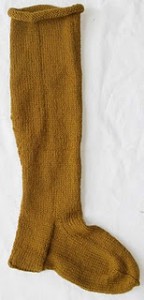 HOSE are worn to just around the knee. A contemporary pattern describes a knee high stocking, turned down over a tied garter. You can buy or (get someone to) knit your own woollen HOSE. A good modern substitute is plain woollen tights or unribbed knitted stockings in any of the drab colours mentioned in the introduction. Shaped linen or cloth hose are also worn. Hose should be held up by GARTERS, either strips of cloth, or knitted.
HOSE are worn to just around the knee. A contemporary pattern describes a knee high stocking, turned down over a tied garter. You can buy or (get someone to) knit your own woollen HOSE. A good modern substitute is plain woollen tights or unribbed knitted stockings in any of the drab colours mentioned in the introduction. Shaped linen or cloth hose are also worn. Hose should be held up by GARTERS, either strips of cloth, or knitted.
Low-heeled LATCHET SHOES were worn by most common people and issued to soldiers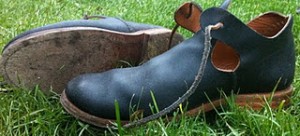 in the wars, although mounted officers and cavalry troopers wear boots. A closed shoe or ankle-boot referred to as a STARTUP can also be worn as a more protective alternative. No clear evidence has been shown for their issue by armies in Britain during this period, though they were common for rural folk so they can’t be ruled out for soldiers.
in the wars, although mounted officers and cavalry troopers wear boots. A closed shoe or ankle-boot referred to as a STARTUP can also be worn as a more protective alternative. No clear evidence has been shown for their issue by armies in Britain during this period, though they were common for rural folk so they can’t be ruled out for soldiers.
Men of all ages kept their heads covered almost all the time. HATS or CAPS were doffed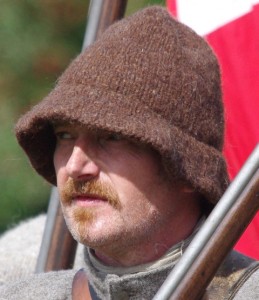 when you met anyone of higher social status or rank or were being polite. For the battlefield, headgear is determined by your fighting role. Pikemen wear morion helmets and musketeers a hat, cap or bonnet. The simplest is the MONMOUTH CAP, a style of knitted woollen cap, heavily felted. It may have been a fairly high conical shape with or without a brim round the edge.
when you met anyone of higher social status or rank or were being polite. For the battlefield, headgear is determined by your fighting role. Pikemen wear morion helmets and musketeers a hat, cap or bonnet. The simplest is the MONMOUTH CAP, a style of knitted woollen cap, heavily felted. It may have been a fairly high conical shape with or without a brim round the edge.
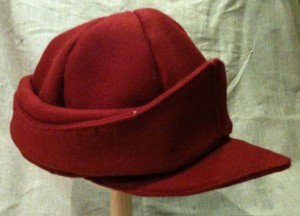 MONTEROS were issued with coats and breeches to Oxford soldiers (us) in 1643. A Montero is a peaked cap made of segments of woollen cloth with a skirt running around the edge that can either fold down for protection in bad weather or up for a stylish peak. Broad-brimmed HATS are also worn, either made from blocked and felted wool/fur or leather.
MONTEROS were issued with coats and breeches to Oxford soldiers (us) in 1643. A Montero is a peaked cap made of segments of woollen cloth with a skirt running around the edge that can either fold down for protection in bad weather or up for a stylish peak. Broad-brimmed HATS are also worn, either made from blocked and felted wool/fur or leather.
To summarise, a soldier’s basic costume, regardless of the fighting arm chosen or the Army that you join, consists of a SHIRT, a pair of BREECHES, a COAT (or DOUBLET), HOSE, SHOES and a HAT. The coat or jacket will be of a colour and cut chosen by the colonel who raised the original Civil War regiment. Sometimes, this applies also to breeches and, occasionally hats. Your regiment will provide relevant details. Shoes, hose and hats can be bought from traders. Some soldiers carry sausage shaped SNAPSACKS, worn across the back from shoulder to hip with a strap diagonally across the chest. CLOAKS or a length of ragged wool or leather for use as a CAPE in the rain may be worn in poor weather but only off the battlefield if portraying soldiers “on campaign” or on guard duty with permission.
Further information, features, articles and pictures of clothes from the 1640s can be found on this website
http://thegoodwyfe.blogspot.com
Thanks to Alan Mackinnon, John Beardsworth, Rusty Aldwinckle and Facebook for photos.
Gillian Thomson & Ian Dicker December 2011

